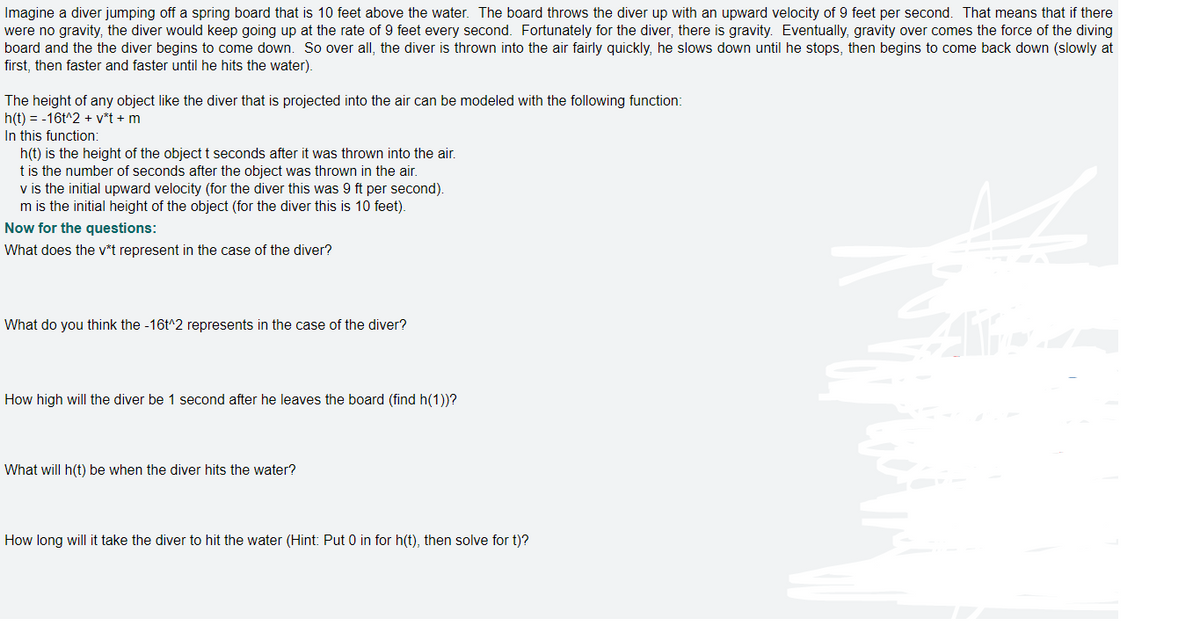Imagine a diver jumping off a spring board that is 10 feet above the water. The board throws the diver up with an upward velocity of 9 feet per second. That means that if there were no gravity, the diver would keep going up at the rate of 9 feet every second. Fortunately for the diver, there is gravity. Eventually, gravity over comes the force of the diving board and the the diver begins to come down. So over all, the diver is thrown into the air fairly quickly, he slows down until he stops, then begins to come back down (slowly at first, then faster and faster until he hits the water). The height of any object like the diver that is projected into the air can be modeled with the following function: h(t) = -16t^2 + v*t + m In this function: h(t) is the height of the object t seconds after it was thrown into the air. t is the number of seconds after the object was thrown in the air. v is the initial upward velocity (for the diver this was 9 ft per second). m is the initial height of the object (for the diver this is 10 feet). Now for the questions: What does the v*t represent in the case of the diver? What do you think the -16t^2 represents in the case of the diver? How high will the diver be 1 second after he leaves the board (find h(1))? What will h(t) be when the diver hits the water? How long will it take the diver to hit the water (Hint: Put 0 in for h(t), then solve for t)?
Imagine a diver jumping off a spring board that is 10 feet above the water. The board throws the diver up with an upward velocity of 9 feet per second. That means that if there were no gravity, the diver would keep going up at the rate of 9 feet every second. Fortunately for the diver, there is gravity. Eventually, gravity over comes the force of the diving board and the the diver begins to come down. So over all, the diver is thrown into the air fairly quickly, he slows down until he stops, then begins to come back down (slowly at first, then faster and faster until he hits the water). The height of any object like the diver that is projected into the air can be modeled with the following function: h(t) = -16t^2 + v*t + m In this function: h(t) is the height of the object t seconds after it was thrown into the air. t is the number of seconds after the object was thrown in the air. v is the initial upward velocity (for the diver this was 9 ft per second). m is the initial height of the object (for the diver this is 10 feet). Now for the questions: What does the v*t represent in the case of the diver? What do you think the -16t^2 represents in the case of the diver? How high will the diver be 1 second after he leaves the board (find h(1))? What will h(t) be when the diver hits the water? How long will it take the diver to hit the water (Hint: Put 0 in for h(t), then solve for t)?
Trigonometry (MindTap Course List)
10th Edition
ISBN:9781337278461
Author:Ron Larson
Publisher:Ron Larson
Chapter3: Additional Topics In Trigonometry
Section3.3: Vectors In The Plane
Problem 11ECP
Related questions
Topic Video
Question

Transcribed Image Text:Imagine a diver jumping off a spring board that is 10 feet above the water. The board throws the diver up with an upward velocity of 9 feet per second. That means that if there
were no gravity, the diver would keep going up at the rate of 9 feet every second. Fortunately for the diver, there is gravity. Eventually, gravity over comes the force of the diving
board and the the diver begins to come down. So over all, the diver is thrown into the air fairly quickly, he slows down until he stops, then begins to come back down (slowly at
first, then faster and faster until he hits the water).
The height of any object like the diver that is projected into the air can be modeled with the following function:
h(t) = -16t^2 + v*t + m
In this function:
h(t) is the height of the object t seconds after it was thrown into the air.
t is the number of seconds after the object was thrown in the air.
v is the initial upward velocity (for the diver this was 9 ft per second).
m is the initial height of the object (for the diver this is 10 feet).
Now for the questions:
What does the v*t represent in the case of the diver?
What do you think the -16t^2 represents in the case of the diver?
How high will the diver be 1 second after he leaves the board (find h(1))?
What will h(t) be when the diver hits the water?
How long will it take the diver to hit the water (Hint: Put 0 in for h(t), then solve for t)?
Expert Solution
This question has been solved!
Explore an expertly crafted, step-by-step solution for a thorough understanding of key concepts.
This is a popular solution!
Trending now
This is a popular solution!
Step by step
Solved in 2 steps with 1 images

Knowledge Booster
Learn more about
Need a deep-dive on the concept behind this application? Look no further. Learn more about this topic, algebra and related others by exploring similar questions and additional content below.Recommended textbooks for you

Trigonometry (MindTap Course List)
Trigonometry
ISBN:
9781337278461
Author:
Ron Larson
Publisher:
Cengage Learning

Trigonometry (MindTap Course List)
Trigonometry
ISBN:
9781337278461
Author:
Ron Larson
Publisher:
Cengage Learning